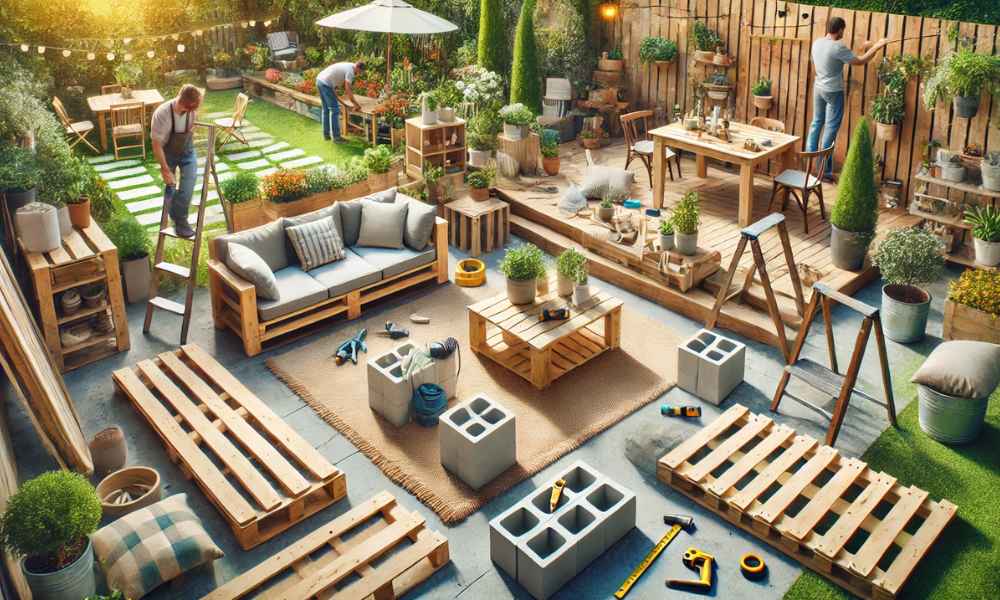Creating an outdoor seating area is more than just assembling chairs and benches—it’s about crafting a space where relaxation meets functionality. Whether you’re looking to enhance your backyard, patio, or garden, building your own outdoor seats can be a fulfilling DIY project that adds charm and practicality to your outdoor space. With the right materials, a touch of creativity, and some hands-on effort, you can create a seating arrangement that is both comfortable and visually appealing. From simple wooden benches to pallet furniture and sturdy cinder block designs, this guide will walk you through how to build outdoor seating tailored to your style and needs.
Choosing the Right Outdoor Seating Style
Before you start gathering tools and materials, consider the style that best suits your outdoor space. Are you going for a rustic, modern, or bohemian aesthetic? Do you need seating for small gatherings, or do you want a spacious lounge area?
- Rustic charm: Wooden benches and log seats give a natural, cozy feel.
- Modern elegance: Sleek metal or minimalist concrete seats adds a contemporary touch.
- Budget-friendly DIY: Pallet furniture or upcycled materials are excellent for those looking for low-cost yet stylish options.
- Built-in seating: If you have a patio or deck, built-in seating can maximize space while adding a seamless look to your outdoor area.
Planning Your Outdoor Seating Project
Proper planning ensures a smooth construction process. Follow these key steps before starting:
- Assess your space: Measure the area to determine how much seating you can fit comfortably.
- Set a budget: Consider costs for materials, tools, and any finishing touches like cushions and stain.
- Choose durable materials: Wood, concrete, metal, or recycled materials—each has its advantages. Pressure-treated wood and weather-resistant finishes help ensure longevity.
- Gather necessary tools: Depending on your chosen style, you may need a saw, drill, screws, sandpaper, and paint or stain.
Step-by-Step Guide on How to Build Outdoor Seating
Now that you’ve planned your project, it’s time to start building. Follow these steps to create durable and stylish seating for your outdoor space.
Preparing Your Workspace: Safety First
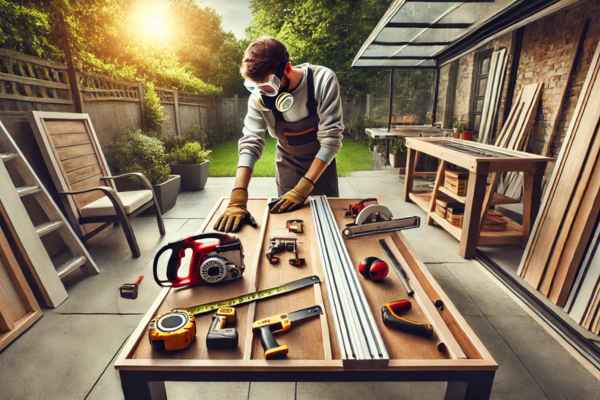
Safety should always be your priority. Before you begin construction, prepare a well-organized workspace.
- Wear protective gear: Safety glasses, gloves, and dust masks will protect you from debris and splinters.
- Work on a stable surface: A flat, solid workbench will make cutting and assembling easier.
- Check your tools: Ensure all power tools are in good working condition and use them according to safety guidelines.
Building a Simple Wooden Bench: A Beginner-Friendly Project
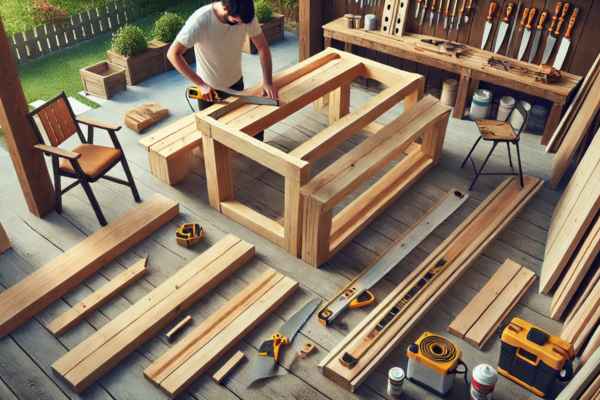
A wooden bench is one of the easiest and most functional seating options. Here’s how to build one:
Materials Needed:
- Pressure-treated lumber (2x4s and 2x6s)
- Screws or nails
- Wood glue
- Sandpaper
- Wood stain or outdoor sealant
Steps:
- Cut the wood: Measure and cut two equal-length pieces for the seat and two shorter pieces for the legs.
- Assemble the frame: Secure the legs to the seat using screws and wood glue.
- Add support beams: For stability, attach horizontal supports underneath.
- Sand the surface: Smooth the wood to prevent splinters.
- Apply a finish: Use a weather-resistant stain or sealant to protect against moisture.
How to Build Outdoor Seating with Pallets: Affordable and Chic
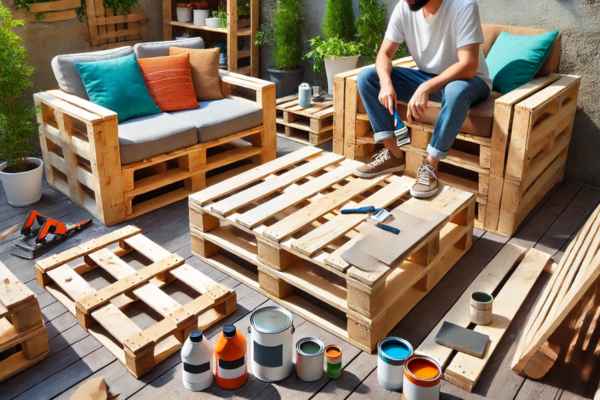
Pallet furniture is an eco-friendly and cost-effective way to create outdoor seats.
Materials Needed:
- Wooden pallets (clean and untreated)
- Nails or screws
- Sandpaper
- Paint or wood stain
Steps:
- Choose sturdy pallets: Inspect for damage and sand rough edges.
- Stack and secure: Arrange pallets to your desired seat height and secure them with nails or screws.
- Add a backrest (optional): Attach a vertical pallet for added support.
- Paint or stain: Customize with a weatherproof finish.
- Add cushions: For comfort, place outdoor cushions or foam padding on top.
DIY Cinder Block Seating: Sturdy, Stylish, and Easy
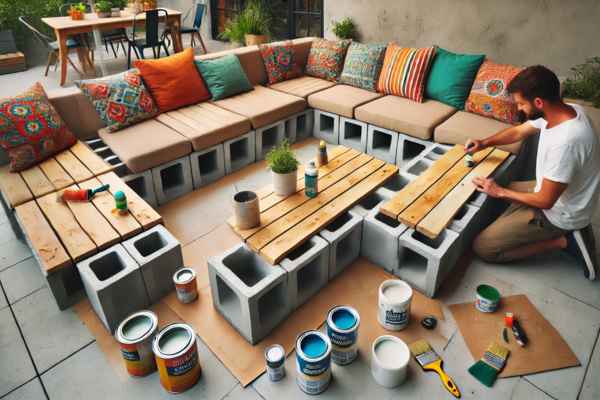
Cinder block seats is a durable and modern alternative to wooden or pallet seating.
Materials Needed:
- Cinder blocks (about 8-10 depending on the size)
- Wooden planks
- Construction adhesive
- Paint (optional)
Steps:
- Position the blocks: Arrange them in a rectangular or L-shape.
- Insert wooden planks: Place treated wood beams through the openings in the cinder blocks.
- Secure with adhesive: Apply construction adhesive to keep blocks in place.
- Paint or decorate: Customize with paint or outdoor-friendly fabric.
- Add cushions: Enhance comfort with padded cushions or outdoor fabric.
Creating Built-In Seating: Maximize Your Outdoor Space
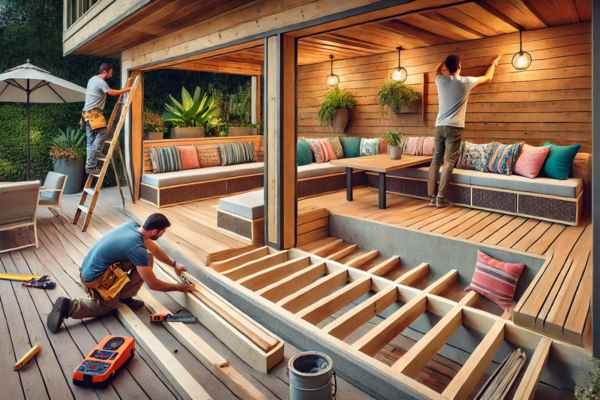
You have a deck or patio, built-in seating provides a seamless and space-efficient option.
Steps:
- Measure and frame: Outline the seats area with wooden framing.
- Secure the base: Use concrete or strong anchor points for stability.
- Install seat panels: Cut and attach wooden panels as the seating surface.
- Sand and finish: Smooth out rough edges and apply weatherproofing treatments.
- Customize with cushions: Add soft, weather-resistant cushions for comfort.
Final Touches: Making Your Seating Area Comfortable and Inviting

Now that your seating is complete, consider ways to enhance the space.
- Add outdoor cushions and throws for extra comfort.
- Incorporate lighting such as lanterns or string lights for ambiance.
- Use plants and decor to blend the seats area with your garden.
- Consider a shade structure like a pergola or umbrella for hot summer days.
Maintenance Tips for Long-Lasting Outdoor Seating
- Regularly check for signs of wear and damage.
- Reapply sealant or stain annually to protect against the elements.
- Store cushions indoors during extreme weather to extend their lifespan.
Adding Comfort and Style to Your DIY Seating
Creating outdoor seating isn’t just about functionality; it’s also about crafting a space where comfort meets aesthetics. Adding plush cushions with weather-resistant fabrics can instantly elevate the coziness of your seats arrangement. Opt for vibrant colors or patterns that complement your outdoor environment to create visual interest. Incorporating throw pillows, cozy blankets, and even outdoor rugs can add layers of texture and warmth, making the space inviting year-round. For a touch of elegance, consider adding string lights, lanterns, or potted plants around your seating area. These simple yet effective enhancements can transform basic seating into a chic outdoor retreat.
Maintenance Tips for Long-Lasting Outdoor Seating
To ensure your outdoor seating stands the test of time, regular maintenance is key. Start by using weather-resistant materials like treated wood, metal, or plastic composites that can withstand harsh conditions. Apply protective sealants or paint to guard against moisture, UV rays, and temperature fluctuations. Clean your seats regularly to prevent mold and mildew buildup, especially after rainy seasons. If you’re using cushions or fabrics, choose ones with removable covers for easy washing. Additionally, consider storing cushions indoors during extreme weather or investing in waterproof covers to prolong their lifespan. Small efforts like these can keep your seating looking fresh and durable for years.
Sustainable and Eco-Friendly Outdoor Seating Ideas
Eco-conscious living extends beyond recycling bins and reusable bags—it can also be reflected in your outdoor seats choices. Consider repurposing old materials like wooden pallets, reclaimed timber, or upcycled cinder blocks to create unique, sustainable seating. Not only do these materials reduce waste, but they also add character and charm to your outdoor space. Bamboo is another eco-friendly option due to its rapid growth and minimal environmental impact. For cushions and fabrics, choose organic or recycled materials whenever possible. By opting for sustainable practices, you’ll create an outdoor space that’s both beautiful and environmentally responsible.
Common Mistakes to Avoid When Building Outdoor Seating
While DIY projects are rewarding, they can also come with pitfalls if you’re not careful. One common mistake is neglecting to measure your space properly, which can result in oversized or cramped seats arrangements. Another oversight is using untreated wood or materials not designed for outdoor use, leading to premature weather damage. Ignoring structural stability is also risky; ensure all joints are secure and that the seating can safely support weight. Additionally, forgetting to account for comfort—like omitting cushions or ergonomic designs—can make even the most stylish seating uncomfortable. Avoid these mistakes to create seating that’s both functional and durable.
What’s the Easiest Type of Outdoor Seating to Build?
If you’re new to DIY projects, start with simple designs like a basic wooden bench or pallet sofa. These projects require minimal tools and straightforward construction techniques. A cinder block and wooden plank bench is another beginner-friendly option—it’s sturdy, stylish, and can be assembled in under an hour with little to no cutting involved. These designs allow you to get creative with finishes and cushions while keeping the construction process stress-free. The key is to choose a project that matches your skill level and gradually build your confidence as you gain experience.
Can I Build Outdoor Seating Without Power Tools?
Absolutely! While power tools can speed up the process, they’re not a necessity for every project. Hand tools like hammers, screwdrivers, hand saws, and wrenches can be used to create sturdy outdoor seats. For example, pallet seating often requires little more than a hammer and nails, while cinder block benches rely on stacking and securing with adhesive rather than drilling or sawing. If you prefer a rustic, handcrafted look, working without power tools can even add charm to your finished piece. It’s all about selecting a project that aligns with your available tools and comfort level.
How Do I Make My DIY Seating More Comfortable?
Comfort is key when it comes to outdoor seats. Start by ensuring the seat height and depth are ergonomic—too low or too deep can strain the back and legs. Adding thick, high-density foam cushions covered in outdoor fabric provides both comfort and durability. Consider adding backrests with an angle for proper support, or even armrests for added relaxation. Incorporating footrests, ottomans, or side tables can also enhance the overall comfort of your setup. Lastly, position your seatsin shaded areas or add umbrellas to protect against harsh sunlight, making the space more enjoyable during warmer months.
Conclusion
Building outdoor seating is more than just a DIY project—it’s an opportunity to create a personalized space for relaxation, gatherings, and outdoor enjoyment. By focusing on comfort, sustainability, and smart design choices, you can craft seatsthat’s both functional and aesthetically pleasing. Whether you’re repurposing old materials, experimenting with simple bench designs, or adding stylish cushions, the possibilities are endless. With a bit of planning, creativity, and care, your outdoor seating will become a cherished part of your home, inviting you to sit back, relax, and enjoy the great outdoors.
